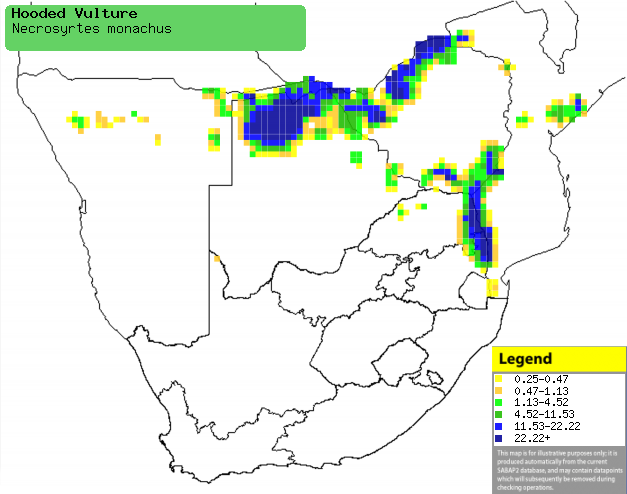|
Necrosyrtes monachus (Hooded
vulture)
MonnikaasvoŽl [Afrikaans]; Ekuvi (generic term for
vulture) [Kwangali]; Gora (generic name for vulture) [Shona]; Lingce
(generic term for vulture) [Swazi]; Koti (generic term for vulture)
[Tsonga]; Kapgier [Dutch]; Vautour charognard [French]; Kappengeier
[German]; Abutre-de-capuz [Portuguese]
Life
> Eukaryotes >
Opisthokonta
> Metazoa (animals) >
Bilateria >
Deuterostomia > Chordata >
Craniata > Vertebrata (vertebrates) > Gnathostomata (jawed
vertebrates) > Teleostomi (teleost fish) > Osteichthyes (bony fish) > Class:
Sarcopterygii (lobe-finned
fish) > Stegocephalia (terrestrial
vertebrates) > Tetrapoda
(four-legged vertebrates) > Reptiliomorpha > Amniota >
Reptilia (reptiles) >
Romeriida > Diapsida > Archosauromorpha > Archosauria >
Dinosauria
(dinosaurs) > Saurischia > Theropoda (bipedal predatory dinosaurs) >
Coelurosauria > Maniraptora > Aves
(birds) > Order: Falconiformes
> Family: Accipitridae
Distribution and habitat
Occurs across much of sub-Saharan Africa, excluding the
lowland forest of the DRC and adjacent countries. In southern Africa it is locally common in the Caprivi Strip
(Namibia), northern Botswana, north-western and southern Zimbabwe, north-eastern
South Africa and central Mozambique. It generally prefers moist savanna,
especially well-developed Mopane (Colosphermum mopane) woodland with
scattered trees, such as Jackal-berry (Diosypros mespiliformis)
and Nyala-tree (Xanthocercis zambesiaca).
|
 |
|
Distribution of Hooded vulture in southern Africa,
based on statistical smoothing of the records from first SA Bird Atlas
Project (©
Animal Demography unit, University of
Cape Town; smoothing by Birgit Erni and Francesca Little). Colours range
from dark blue (most common) through to yellow (least common).
See here for the latest distribution
from the SABAP2. |
Predators and parasites
It has been recorded as a host of four louse species, of
which two are only found on the Hooded vulture:
- Aegypoecus hopkinsi
- Falcipeurus monilis
Movements and migrations
Resident and sedentary.
Food
It is spends most of it's time scavenging, soaring high in the air until it
spots a carcass, at which point it descends to the ground to feed. Once on the
scene, it feeds on meat, eyes, offal and bones; if it is an old carcass it may
take maggots and insects from the body. It also eats the dung of lions and
humans, sometimes hawking
termite alates and taking Tawny eagle
and Red-billed quelea
nestlings from their nests.
Breeding
- Monogamous, usually solitary nester, although it is sometimes
semi-colonial; pairs probably stay together for life.
- The nest is built by both sexes, consisting of a compact
structure of sticks with a cup set into the centre, lined with dry grass and green
leaves. It is typically placed in a fork near the top of a large
well-foliaged tree, especially Jackal-berry (Diospyros mespiliformis)
or Nyala-tree (Xanthocercis zambesiaca), often near a river or
stream.
- Egg-laying season is from June-September, peaking from June-July.
- It almost invariably lays a single egg, which is incubated by both sexes for
about 48-54 days.
- The chick is constantly brooded by both parents for the first three
weeks or so of its life, and is fed by both parents. It leaves the nest at
about 90-130 days old, becoming fully independent roughly four months later.
Threats
Not threatened globally, but Vulnerable in South
Africa, as its population has recently decreased by about 10% in the country, and
is now estimated to be less than 100 breeding pairs.
References
-
Hockey PAR, Dean WRJ and Ryan PG 2005. Roberts
- Birds of southern Africa, VIIth ed. The Trustees of the John Voelcker
Bird Book Fund, Cape Town.
|
